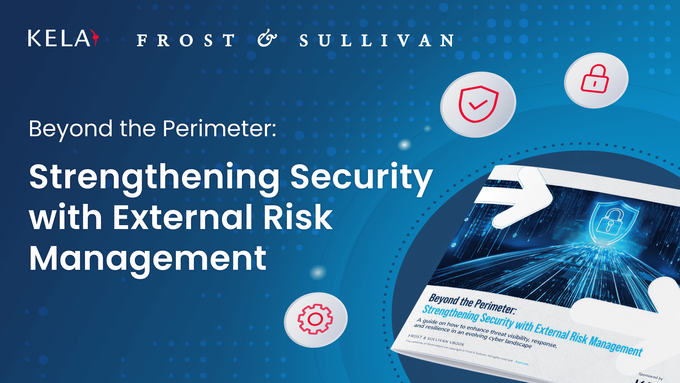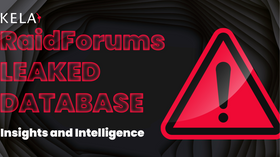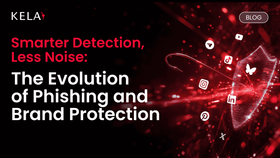External Risk Management: Fixing the Errors of Traditional Security
External Risk Management (ERM) is the strategic shift toward addressing threats beyond the traditional network perimeter, where the majority of modern cyberattacks now originate.
Updated May 7, 2025

Cyber threats no longer stop at the firewall. As organizations expand their digital footprint across cloud platforms, remote endpoints, and third-party vendors, so does their exposure to unseen risks.
However, most security strategies still remain inward-facing. While EDRs, firewalls, and SIEMs monitor what's inside, attackers are increasingly exploiting what's left unmonitored on the outside. From leaked credentials on the dark web to misconfigured cloud assets, these blind spots are becoming entry points.
To stay ahead, organizations need more than detection, they also need visibility. That’s where external threat exposure reduction (what Frost & Sullivan refers to as External Risk Management) comes in.
» Skip the summary and download the full Frost & Sullivan Report
Why Your Digital Footprint Doesn't End at the Firewall
Modern organizations operate far beyond the boundaries of their internal networks, expanding the attack surface through:
- Cloud workloads
- Remote employees
- Third-party tools
- Internet-facing services
This amounts to a 133% year-over-year increase in cyber assets—a sprawl that introduces risk in places traditional tools can't reach.
Endpoint detection (EDR), firewalls, and SIEMs still play a role, but they were designed for internal visibility. They don't flag exposed S3 buckets, leaked credentials on the dark web, or fake login pages spoofing your brand.
Without external visibility, attackers get the upper hand. Security leaders need to account for everything that touches the internet, not just what's inside the perimeter.
» Make sure you know about the most targeted entry points by hackers
The Booming Business of Cybercrime
Cybercrime has become a scalable industry. With the rise of cybercrime-as-a-service (CaaS), threat actors no longer need advanced skills. Instead, all they need is access to the right marketplace. From phishing kits and initial access brokers to stolen credentials and remote access tools on dark web marketplaces, the underground economy is thriving.
These tools lower the barrier to entry and accelerate attack speed. A single leaked credential or misconfigured asset can now trigger a full-scale breach, often with weeks of lead time visible on dark web channels or Telegram groups.
Cybercrime is becoming so easy that the number of attacks leveraging compromised credentials increased by 71% year-over-year, with the average cost of a data breach growing by the millions.
» Stay up to date with the key cyber threats coming in 2026
Why Lack of Visibility Is Security’s Biggest Weakness
Most breaches don’t happen because attackers are smarter—they happen because organizations can’t see what’s exposed and often go unnoticed until it's too late. These include:
- Shadow IT
- Forgotten subdomains
- Misconfigured cloud assets
- Leaked credentials
Consequences of Alert Fatigue
Meanwhile, security teams are buried in noisy alerts and siloed tools, lacking the external context needed to prioritize. It becomes impossible to maintain visibility over your attack surface with manual processes—the sheer volume of data that must be combed through is extremely time-consuming and prone to errors from human oversight.
Without visibility into how threat actors target exposed assets, often advertised weeks in advance, teams remain reactive instead of prepared, leading to the following potential consequences:
- Brand damage: Breaches like the SolarWinds attack cause negative publicity that results in a loss of customer trust, decreased stock value and investor confidence, and loss of potential business opportunities.
- Regulatory fines: Failure to meet compliance with regulatory standards like the GDPR and HIPAA can result in significant financial penalties, increased regulatory scrutiny, and even legal action.
- Operational downtime: When you lack visibility into your network and systems, cyberattacks can go undetected for longer, and recovery efforts can be hampered, pausing business operations, inhibiting productivity.
Introducing What Frost Calls External Risk Management (ERM)
Frost & Sullivan defines External Risk Management (ERM) as the strategic shift toward addressing threats beyond the traditional network perimeter, where the majority of modern cyberattacks now originate.
Rather than focusing solely on internal logs and endpoints, ERM emphasizes visibility into adversary behavior, exposed assets, and dark web activity.
Key Components of ERM
- Cyber threat intelligence (CTI): Understand who is targeting your organization, why, and how, based on real-world adversary behavior.
- External attack surface management (EASM): Identify and reduce exposure of internet-facing assets and misconfigured services through continuous, real-time monitoring.
- Digital risk protection (DRP): Monitor for brand impersonation, leaked data, and credential theft across the open, deep, and dark web.
- Third-party risk management (TPRM): Assess and mitigate risks coming from vendors and partners in your ecosystem.
- Generative AI: Automate analysis of vast external datasets to accelerate detection, triage, and prioritization.
» Learn more: The power of KELA's cyber threat intelligence platform
Benefits of ERM
- Improved visibility: Gain a comprehensive view of your external-facing assets, identify vulnerabilities, manage third-party risks effectively, and swiftly pinpoint and remediate exploitable weaknesses.
- Proactive security: Leverage real-time threat intelligence and automated workflows to anticipate and prevent cyberattacks before they can cause damage.
- Boosted productivity: Automation reduces manual tasks in security operations and accelerates threat investigations.
- Cost savings: Avoid significant financial losses associated with fraud and data breaches, and optimize security operations through automation.
- Enhanced compliance: Strengthen adherence to relevant regulations and standards by proactively managing external risks and maintaining a clear security posture.
- Better team collaboration: Foster improved communication and coordination among security teams by providing a unified view of external risks and streamlined workflows.
» Download the full Frost & Sullivan Report





